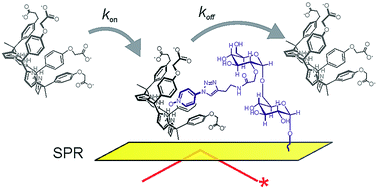Using a commercial instrument that integrates microfluidics with surface plasmon resonance (SPR) detection, we thermodynamically and kinetically characterise the interactions of water-soluble calix[4]pyrroles with surface-immobilized guests derived from pyridine N-oxide. This technique provides detailed information in real time and shows that, while thermodynamically similar, the binding process occurring with the surface-immobilised guests is kinetically very different to that in solution. Two different binding processes can be distinguished for the surface-immobilised guests. Both complexation processes provide 1:1 complexes with thermodynamic stabilities that are similar to each other and to the 1:1 complex formed in solution. However, the kinetic stabilities of the complexes formed with the surface anchored ligands are significantly higher. These observations are rationalized on the basis of the effects exerted by the dextran matrix employed for the ligand’s immobilisation on the small molecule complexes that are formed.
